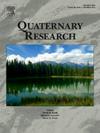由陆地蜗牛壳的同位素值推断的阿拉斯加内陆晚冰期-新仙女木期气候
IF 1.8
3区 地球科学
Q3 GEOGRAPHY, PHYSICAL
引用次数: 0
摘要
螺壳化石的同位素值可以作为重要的气候资料。本文首次测定了阿拉斯加内陆地区蜗牛壳的碳(δ 13c)和氧(δ 18o)同位素值,探讨了晚冰期植被和湿度的变化。螺壳δ 13c值在晚冰期较为一致。晚冰期壳δ 13c值比现代壳高2.8‰。这种抵消最好的解释是susess效应和蜗牛饮食中δ 13c值的变化。螺壳δ 18o值在晚冰期发生了变化,相对湿度(RH)的变化可以部分解释这一变化。根据已发表的通量平衡模型对蜗牛生长期间的RH进行了建模。结果表明,b ølling - allero ød期(~14 ka)初期为干燥期,随后是新仙女木期的两个不同阶段,新仙女木期早期为湿润期(12.9 ~ 12.3 ka),新仙女木期晚期为干燥期(12.3 ~ 11.7 ka)。结果表明,高纬度地区的陆地蜗牛同位素可以作为一种补充的古气候代用物,帮助阐明复杂的气候历史,例如新仙女木期阿拉斯加内陆的气候历史。本文章由计算机程序翻译,如有差异,请以英文原文为准。
Late glacial–Younger Dryas climate in interior Alaska as inferred from the isotope values of land snail shells
Abstract The isotope values of fossil snail shells can be important archives of climate. Here, we present the first carbon (δ 13 C) and oxygen (δ 18 O) isotope values of snail shells in interior Alaska to explore changes in vegetation and humidity through the late-glacial period. Snail shell δ 13 C values were relatively consistent through the late glacial. However, late-glacial shell δ 13 C values are 2.8‰ higher than those of modern shells. This offset is best explained by the Suess effect and changes in the δ 13 C values of snail diet. Snail shell δ 18 O values varied through the late glacial, which can be partially explained by changes in relative humidity (RH). RH during the snail growing period was modeled based on a published flux balance model. Results suggest a dry period toward the beginning of the Bølling–Allerød (~14 ka) followed by two distinct stages of the Younger Dryas, a wetter stage in the early Younger Dryas from 12.9 to 12.3 ka, and subsequent drier stage in the late Younger Dryas between 12.3 and 11.7 ka. The results show that land snail isotopes in high-latitude regions may be used as a supplementary paleoclimate proxy to help clarify complex climate histories, such as those of interior Alaska during the Younger Dryas.
求助全文
通过发布文献求助,成功后即可免费获取论文全文。
去求助
来源期刊

Quaternary Research
地学-地球科学综合
CiteScore
4.70
自引率
8.70%
发文量
57
审稿时长
3 months
期刊介绍:
Quaternary Research is an international journal devoted to the advancement of the interdisciplinary understanding of the Quaternary Period. We aim to publish articles of broad interest with relevance to more than one discipline, and that constitute a significant new contribution to Quaternary science. The journal’s scope is global, building on its nearly 50-year history in advancing the understanding of earth and human history through interdisciplinary study of the last 2.6 million years.
 求助内容:
求助内容: 应助结果提醒方式:
应助结果提醒方式:


